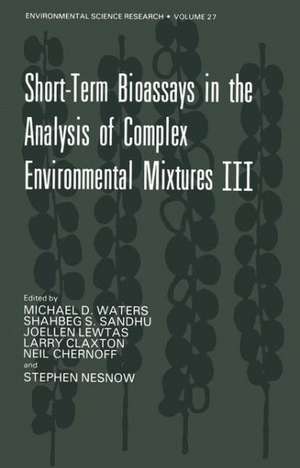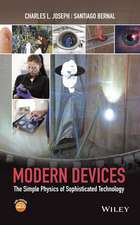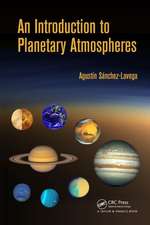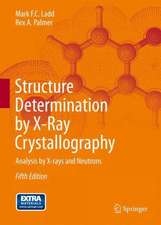Short-Term Bioassays in the Analysis of Complex Environmental Mixtures III: Environmental Science Research, cartea 27
Editat de Michael D. Watersen Limba Engleză Paperback – noi 2011
Din seria Environmental Science Research
-
 Preț: 405.28 lei
Preț: 405.28 lei - 15%
 Preț: 583.75 lei
Preț: 583.75 lei -
 Preț: 413.76 lei
Preț: 413.76 lei -
 Preț: 386.81 lei
Preț: 386.81 lei -
 Preț: 391.61 lei
Preț: 391.61 lei -
 Preț: 403.53 lei
Preț: 403.53 lei -
 Preț: 398.74 lei
Preț: 398.74 lei -
 Preț: 405.06 lei
Preț: 405.06 lei -
 Preț: 397.59 lei
Preț: 397.59 lei -
 Preț: 410.66 lei
Preț: 410.66 lei -
 Preț: 410.88 lei
Preț: 410.88 lei -
 Preț: 391.02 lei
Preț: 391.02 lei - 15%
 Preț: 656.25 lei
Preț: 656.25 lei - 18%
 Preț: 1253.54 lei
Preț: 1253.54 lei - 15%
 Preț: 602.40 lei
Preț: 602.40 lei - 5%
 Preț: 387.58 lei
Preț: 387.58 lei -
 Preț: 409.89 lei
Preț: 409.89 lei -
 Preț: 406.80 lei
Preț: 406.80 lei -
 Preț: 415.29 lei
Preț: 415.29 lei -
 Preț: 426.06 lei
Preț: 426.06 lei -
 Preț: 394.29 lei
Preț: 394.29 lei -
 Preț: 406.05 lei
Preț: 406.05 lei -
 Preț: 403.15 lei
Preț: 403.15 lei -
 Preț: 409.13 lei
Preț: 409.13 lei -
 Preț: 433.36 lei
Preț: 433.36 lei -
 Preț: 399.50 lei
Preț: 399.50 lei - 15%
 Preț: 592.07 lei
Preț: 592.07 lei -
 Preț: 391.02 lei
Preț: 391.02 lei -
 Preț: 395.85 lei
Preț: 395.85 lei - 5%
 Preț: 1106.33 lei
Preț: 1106.33 lei -
 Preț: 391.79 lei
Preț: 391.79 lei - 5%
 Preț: 378.97 lei
Preț: 378.97 lei -
 Preț: 395.09 lei
Preț: 395.09 lei - 15%
 Preț: 670.82 lei
Preț: 670.82 lei -
 Preț: 395.85 lei
Preț: 395.85 lei - 5%
 Preț: 720.31 lei
Preț: 720.31 lei -
 Preț: 452.04 lei
Preț: 452.04 lei - 18%
 Preț: 1834.77 lei
Preț: 1834.77 lei -
 Preț: 399.50 lei
Preț: 399.50 lei - 18%
 Preț: 953.20 lei
Preț: 953.20 lei - 15%
 Preț: 664.61 lei
Preț: 664.61 lei - 18%
 Preț: 951.77 lei
Preț: 951.77 lei -
 Preț: 389.31 lei
Preț: 389.31 lei - 18%
 Preț: 947.98 lei
Preț: 947.98 lei
Preț: 405.53 lei
Nou
Puncte Express: 608
Preț estimativ în valută:
77.61€ • 80.72$ • 64.07£
77.61€ • 80.72$ • 64.07£
Carte tipărită la comandă
Livrare economică 10-16 aprilie
Preluare comenzi: 021 569.72.76
Specificații
ISBN-13: 9781461336136
ISBN-10: 1461336139
Pagini: 608
Ilustrații: 589 p.
Dimensiuni: 156 x 244 x 32 mm
Ediția:Softcover reprint of the original 1st ed. 1983
Editura: Springer Us
Colecția Springer
Seria Environmental Science Research
Locul publicării:New York, NY, United States
ISBN-10: 1461336139
Pagini: 608
Ilustrații: 589 p.
Dimensiuni: 156 x 244 x 32 mm
Ediția:Softcover reprint of the original 1st ed. 1983
Editura: Springer Us
Colecția Springer
Seria Environmental Science Research
Locul publicării:New York, NY, United States
Public țintă
ResearchCuprins
Session 1: Collection And Preparation of Environmental Samples for Bioassays.- Some Aspects of Mutagenicity Testing of the Particulate Phase and the Gas Phase of Diluted and Undiluted Automobile Exhaust*.- Source Assessment Sampling System (SASS) Versus Dilution Tunnel Sampling*.- Preparation of Hazardous and Complex Samples for Ecological Testing*.- Sample Collection and Preparation Methods Affecting Mutagenicity and Cytotoxicity of Coal Fly Ash*.- The Use of Short-Term Bioassays to Monitor the Environmental Impact of Land Treatment of Hazardous Wastes*.- Mutagenicity Testing of Complex Mixtures Derived from Human Body Fluids*.- Evaluation by the Tradescantia Micronucleus test of the Mutagenicity of Internal Combustion Engine Exhaust Fumes from Diesel and Diesel-Soybean Oil Mixed Fuels+.- Session 2: Application of Bioassays to the Characterization of Hazardous Components.- Microbial Assays in Research and in the Characterization of Complex Mixtures*.- Fractionation of an Oil Shale Retort Process Water: Isolation of Photoactive Genotoxic Components*.- The Integration of Bioassay and Physiochemical Information for Complex Mixtures*.- Session 3: Development of Short-Term Bioassays: Mutagenicity and Cytotoxicity.- Isolation of Mutagens from Drinking Water: Something Old, Something New*.- Mutagenicity Testing of Complex Environmental Mixtures with Chinese Hamster Ovary Cells*.- Bioassays of Oil Shale Process Waters in Paramecium and Salmonella*.- A Search for the Identity of Genotoxic Agents in the Ambient Air Using the Tradescantia Bioassay*.- Relationship(s) Between Mutation and Cytotoxicity Induced InVitro*.- The Mouse Oocyte Toxicity Assay*.- Application of Bovine Macrophage Bioassays in the Analysis of Toxic Agents in Complex Environmental Mixtures*.- Determination ofDirect-Acting Mutagens and Clastogens in Oil Shale Retort Process Water*.- Unscheduled DNA Synthesis in Hamster Tracheal Epithelium Exposed InVitro to Chemical Carcinogens and Environmental Pollutants+.- InVitro Mutagenicity Testing of Ohio Coal-Derived Materials+.- Presence of Various Types of Mutagenic Impurities in Carbon Black Detected by the Salmonella Assay+.- Session 4: Development of Short-Term Bioassays: Carcinogenicity.- Criterion Development for the Application of BALB/c-3T3 Cells to Routine Testing for Chemical Carcinogenic Potential*.- A Quantitative, Clonal Assay for Carcinogen-Induced Alterations of Respiratory Epithelial Cells in Culture*.- Recent Experience with the Strain A Mouse Pulmonary Tumor Bioassay Model*.- Integrated Chemical and Biological Analysis of Asphalt and Pitch Fumes*.- Mouse Skin Carcinogenesis: Application to the Analysis of Complex Mixtures*.- Session 5: Development of Short-Term Bioassays: Teratology.- Frog Embryo Teratogenesis Assay: Xenoplus (FETAX) -- A Short-Term Assay Applicable to Complex Environmental Mixtures*.- Human Serum Teratogenicity Studies Using In Vitro Cultures of Rat Embryos*.- A Teratology Test System which Utilizes Postnatal Growth and Visibility in the Mouse*.- Session 6: Integrated Assessment.- Mutagenicity of Pulp and Paper Mill Effluent: A Comprehensive Study of Complex Mixtures*.- Evaluation in Man and Animals of Tests for the Detection of Population Exposures to Genotoxic Chemicals*.- Biological Activity of Air Particulate Extracts (APE) in Short-Term Tests*.- On the Use of Relative Toxicity for Risk Estimation*.- Passive Smoking and Urban Air Pollution: Salmonella/Microsome Mutagenicity Assay of Simultaneously Collected Indoor and Outdoor Particulate Matter*.- Environmental Aromatic Nitro Compounds and Their Bacterial Detoxification*.- Application of Mutagenicity Tests for Detection and Source Assessment of Genotoxic Agents in the Rubber Work Atmosphere*.- Mutagens in Airborne Particulate Pollutants and Nitro Derivatives Produced by Exposure of Aromatic Compounds to Gaseous Pollutants*.- *Invited paper.








